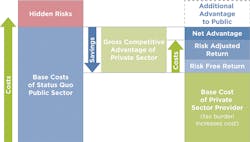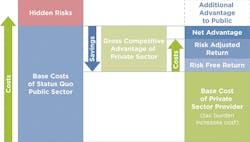Guest Commentary: Infrastructure Innovation Critical for Addressing Water Crises
Those who believe that problems are opportunities may already be aware of the global problem surrounding eroding and antiquated infrastructure. Infrastructure comprises the fundamental facilities and services that are essential for an economy to function and societal living conditions to be sustained or enhanced. These facilities and services typically include bridges, tunnels, airports, water supply, sewers and sanitation, power and power distribution, communications, etc. When it comes to responding to the global water crisis, I believe infrastructure innovation is critical.
The World Economic Forum’s annual Global Risks report released in January of 2015 identified the water crisis as the most serious problem facing the world today—for the first time, ahead of infectious disease epidemics, weapons of mass destruction, or even climate change. It cited drought, water quality, flooding, and ecological damage as the four causes.
Water worries in the US extend beyond California and western states. Even in south Florida, which receives 60 inches of rain per year, shortages persist due to lack of favorable groundwater replenishment caused by nutrient pollution (particularly nitrogen and phosphorus). Conditions such as these are forcing some municipalities to upgrade from traditional wastewater treatment and biosolids/organic waste management to technologies that will allow them environmentally beneficial and economically viable reuse. But the transition is not fast enough.
Leading With Technology Innovation
Archaic thought and technology have been plaguing this industry. There is clearly a fundamental disconnect between its basic infrastructure and our society’s general, more pervasive technical revolution.
Until EPA granted approval in 2010 for a new technology aimed at treating and reutilizing wastewater sludge and organic waste at a fraction of status quo costs and energy consumption, the same antiquated technology (aerobic digestion) had been in use for over 100 years. Despite the extreme progress this country has been experiencing during the same period (national and private space exploration, smartphones, artificial intelligent computers, the move to self-driving cars, etc.), the wastewater treatment needle barely budged. It’s almost inconceivable that these utilities are not able to lower capital investments, operating costs, and energy consumption with all the advancements that are occurring around them.
Making the situation worse, these facilities are charged with meeting regulatory requirements that protect the public’s health and the environment at reasonable and fair rates. Technology innovation is essential for enabling these facilities to provide more cost-effective and more environmentally advantageous services. There is an urgent need to shift how we view wastewater treatment and move to sustainable, strategic infrastructure solutions that deliver energy-saving technologies, while meeting increasing demand spawned by population growth. It is urgent we replace antiquated technologies within existing sites. At the same time, technology must enable higher levels of resource recovery (such as phosphorus and nitrogen) during wastewater treatment in order to reduce landfill use and improve soil quality—two extremely high-priority environmental issues that are reflected in more stringent local, state, and national regulations.
Energy Efficiency
Although energy efficiency has not historically been at the top of the list of priorities in the wastewater treatment industry, it is becoming a primary budget and environmental concern for municipal plants. They are the largest consumer of energy produced in the US (3–4%), with biosolids treatment often drawing 30–50% of this energy consumption. Energy cost is the second-highest budget item for municipal wastewater facilities, after labor costs, eating up as much as 30–40% of a municipality’s total energy bill. The 20% increase in demand projected by EPA will make municipalities more hard-pressed than ever to reduce energy consumption by their largest users.
Thanks to newer EPA-approved chemical technologies, municipalities can replace their energy-intensive aerobic digestion systems. The greatest demand for energy in wastewater treatment (approximately 30–50%) is for providing oxygen to a biological system (aerobic digestion) that is outmoded by today’s standards. Now there is a low-energy treatment alternative to conventional aeration that can be implemented within existing infrastructures.
Approval of new solutions in the last few years marks a milestone in innovating wastewater treatment and biosolids management. These solutions have been used to pre-treat municipal biosolids prior to other processes with very positive results related to secondary sludge, blends of primary and secondary sludge, and blends of secondary sludge and post-consumer food waste prior to aerated static pile composting. Pre-treatment of secondary sludge or blended waste is proven to lessen cake odor while improving dewatering characteristics. The effect of these technologies when combined with sludge-drying technologies has demonstrated enhanced dewatering characteristics of biosolids, a substantial reduction in thermal energy required for drying, and reduced odor, resulting in significant cost and energy benefits in material handling and storage.
Access to Innovations Through Partnerships
Lingering effects of the global economic recession have placed additional financial burden on wastewater utilities concerned with meeting increasingly strict discharge requirements with aging infrastructure in need of repair and replacement. The introduction of a new technology is also an appropriate time to consider reforming traditional project delivery methods to help biosolids treatment facilities address capital and operating challenges. In addition, technology innovators can accelerate adoption of their disruptive technologies by initiating public and private partnerships that are structured to provide attractive financial and service support.
Cost reductions are immediately available to the public sector if there are: (1) hidden risks (see sidebar for examples); (2) accessible innovations available only through private offerings; (3) efficiency improvements created by private industry expertise; or, (4) underutilized assets. These four elements create the “Gross Competitive Advantage of the Private Sector.” The graphic above details the benefits of public-private partnerships to the public and private counterparties.
As an example, a partnership for the management of biosolids could entail a cost-effective offering that would help municipalities reduce overall installation costs, operating costs, and reduce regulatory risk (due to decreasing availability of disposition outlets). Specific components of this comprehensive solution could include:
- Wastewater treatment facility and process design, construction, and maintenance
- Transportation
- Disposition of biosolids on a long-term basis along with nutrient management plans
- Permitting and managing disposition sites
- Private sector responsibility for the marketing of products and/or energy produced for reuse
Sustainable Future
To help ensure a sustainable infrastructure with adequate supplies of water, we must continue to develop innovative technologies and approaches that reduce the “frictional” cost of adoption and proliferation of solutions, reduce consumption (energy, water, commodities, etc.), and ultimately produce products and/or energy from waste streams for reuse. Accelerating the rate in which new concepts and technologies are vetted and integrated throughout infrastructures in the United States and the world can be the single greatest lever we have in solving our global infrastructure deficit. I challenge thought leaders around the globe to join me in making basic infrastructure to be cheaper, more environmentally responsible, and more productive—as well as last longer. We owe it to the generations to come.


